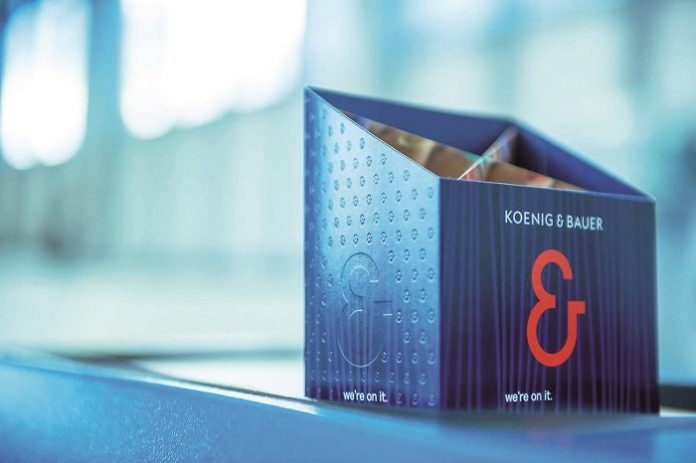
Between 29 November and 1 December 2017, KBA-Sheetfed invited international print and finishing specialists to a series of Print & Postpress Innovation Days at the company’s facility in Radebeul near Dresden. Over 250 participants from 30 countries took the opportunity to gather information on the latest automation solutions for commercial, label and packaging printing, as well as innovative postpress solutions.
Ralf Sammeck, chief executive officer of KBA-Sheetfed, welcomed the experts and talked about the company’s new branding and vision while Sascha Fischer, head of product management, shed light on the several innovative solutions for an increasingly automated printing process being presented. Fischer began by speaking about a new generation of plate changers with significantly reduced change-times in half, medium and large formats, alongside the ability to load plates without prior bending of the rear edges.
New measuring system options such as Print Check and PDF Check make use of a single, common camera system and guarantee absolute inspection and control precision. LED-UV dryers for Rapida sheetfed offset presses are now manufactured by KBA-Sheetfed itself, and said to be even more finely adapted to the Rapida press series offering greater drying performance across all format classes, including large formats.

Helbig and Mario Gerber during their
joint presentation of two Rapida RDC
106 rotary die-cutters for different
fields of application
Autonomous printing with ErgoTronic AutoRun is about to be raised to a new level. “The future belongs to AutoPrint,” said Fischer – not least because the system will soon be able to program a complete job changeover itself, without any need for operator input. And the Rapida LiveApp is already in practical use in the field, with a further expanded scope of features. These include an info panel with press status display and print job information, while the maintenance manager and the consumables tracking module have been complemented with stock management controls and PressCall Mobile, a communication tool with chat functions for service and operator support purposes.
High performance and automation in practice
During the subsequent practical session, Dirk Winkler, head of print technology, demonstrated the printing of labels and folding cartons on a 6-color Rapida 106 coater press with reel sheeter and a Vinfoil Micro cold foil module. His presentation laid emphasis on the benefits of low-migration LED-UV production – the simple flexibility to incorporate cold foil application, and high-speed production at 20,000 sheets per hour both on reel-fed IML film, on cardboard, and self-adhesive label substrates from a pile.
On two 8-color perfector presses for 4-over-4 production with subsequent coating, Winkler and Fischer provided impressive proof of the performance capabilities of the Rapida technology in commercial printing with conventional and LED-UV inks. The conventional press ran six sections of the Koenig & Bauer Report, with fully automatic management of the entire job sequence by ErgoTronic AutoRun. As soon as the defined run length was reached – in this case 500 sheets – the next makeready process began automatically. PrintCheck and PDFCheck provided for continuous quality monitoring.
The LED-UV press produced six sections of the new Koenig & Bauer image brochure and, to conclude, a pencil box on folding carton board. Here, too, job changes were initiated automatically once the run length was reached, and the press subsequently returned to production without manual intervention. It was only the necessary substrate change for the last job which required manual intervention on the part of the operator.
Ultimate die-cutting performance – the rotary die-cutter
Under the claim ‘Ready for the next step,’ Mario Gerber, senior sales manager for postpress solutions, introduced the rotary die-cutter Rapida RDC 106 as a “game-changer for the die-cutting process.” He explained the design features of the rotary die-cutter, which many converters have been keenly waiting for. The design is similar to that of a Rapida printing press with the various converting process steps implemented in the individual towers. These range from die-cutting and hole punching for in-mold and other label applications, as well as embossing, creasing, cutting and stripping for the processing of packaging products, through to tailored variants for commercial users. The machines offer cutting output of up to 15,000 sheets per hour, depending on the substrate and the required contours, and can thus match the speed of a modern sheetfed-offset press. Productivity is increased by up to 300% for label applications, and folding carton producers can also look forward to a 65% increase in efficiency.

the Laserck Master Blanker
The visitors were able to witness this superlative die-cutting performance for themselves during practical demonstrations on two Rapida RDC 106 rotary die-cutters. The 4-unit machine began with a job requiring the creasing, cutting and stripping of a folding carton for pharmaceuticals. At the end of production, the machine was converted within just a few minutes for a completely different job, namely the pencil box printed during the morning session. Subsequent blanking was done offline on a Master Blanker from Laserck with a throughput of up to 20,000 sheets per hour.
The single-unit Rapida RDC 106 rounded off the day by processing the in-mold and self-adhesive labels, which had been printed on the 6-color Rapida 106 with coater and cold foil module. Despite the tricky job change from classic die-cutting to kiss-cutting, the machine was back in production in no time. As the final highlight of the show, the Rapida RDC 106 then ran the self-adhesive label production at a world record speed of 17,000 sheets per hour.
International exchanges of experience
Partner companies Wink and Esko accompanied the event with specialist information on rotary tables and process-integrated workflows for packaging production. The event afforded plenty of opportunities to talk shop and discuss experiences with fellow users from other countries and continents.







